How to communicate the results of a double materiality assessment?
“Once you have the data, you need to communicate them“. Some work is required to convert raw data collected during a double materiality assessment into compelling insights. The non-trivial question must be answered: “What is the best way for that?”. The simple answer is to “put them into a matrix”. However, creating a double materiality matrix might be more challenging than it initially seems. In this blog post, we share some results from our research on double materiality matrices, discuss the various approaches and propose a template that might be a good starting point for those preparing their materiality matrices.
Double materiality – a primer
We observe a significant transformation in corporate reporting on sustainability performance as various ESG reporting standards converge. Regulatory requirements drive this convergence or consolidation, but, more importantly, it is driven by the demands of investors seeking more mature, reliable and materially important corporate sustainability performance information. We have covered the investor’s perspective in our blog posts on the “Eurosif Report on climate-related data” [1] and our main takeaways from that study [2].
However, irrespective of the reporting framework used to disclose non-financial information or to report sustainability performance, organisations must first identify what is material to them before developing an effective sustainability strategy [3] – a strategy that will set the foundations for establishing targets, enabling monitoring of progress towards the goals and ultimately reporting to relevant stakeholder groups.
The concept of double materiality incorporates the “outside-in” and the “inside-out” perspective and, by doing so, shifts the view on materiality from a shareholder to a stakeholder perspective.
The [draft] ESRS General Requirements [4] states: “Double materiality is a concept which provides criteria for the determination of whether a sustainability matter has to be included in the undertaking’s sustainability report. Double materiality is the union (in mathematical terms, i.e., union of two sets, not intersection) of impact materiality and financial materiality. A sustainability matter, therefore, meets the criteria of double materiality if it is material from either the impact perspective or the financial perspective or both perspectives.“
We have already covered the “how to” of materiality assessments in our blog posts [5], [6] and ask you to refer to those posts for further details.
How to communicate the results of a materiality assessment using a double materiality matrix?
The results of the double materiality assessment are mapped to a materiality matrix so they can be communicated to stakeholders. The materiality matrix serves as a visual representation of the comprehensive data gathered and analysed through the stakeholder engagement process. In other words: It effectively charts the material topics along the x- and y-axes, with one axis representing the financial materiality (outside-in perspective) and the other representing the impact materiality (inside-out perspective).
Various options to create a double materiality matrix
Our research found various approaches to building a double materiality matrix that may be influenced by the granularity of the data available and the breadth of data that a firm wants to convey. In general, we have observed three broad types of materiality matrices:
- quadrants or boxes in grids
- zoning
- scatter bubbles
Note: We generated typical examples for each type mentioned above to avoid copyright infringement.
Quadrants or boxes in grids
The most basic representation of the results can be a simple two by two matrix where the material issues are placed in one of the four quadrants based on their importance in the financial and impact dimension.
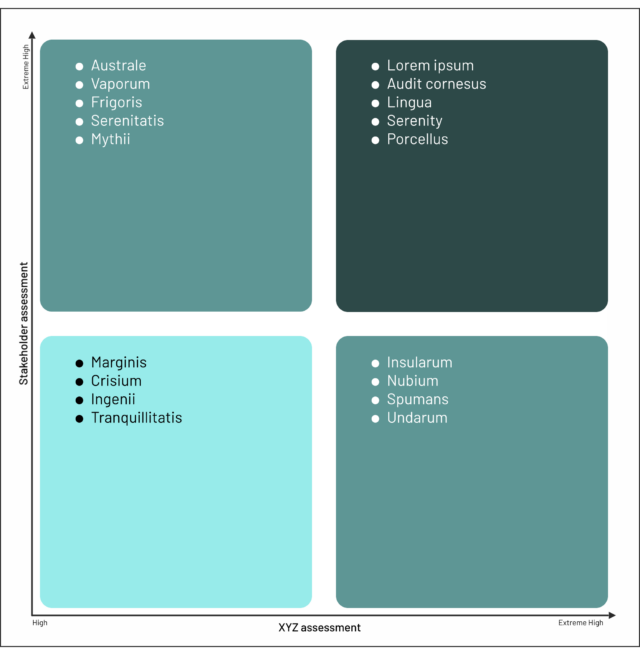
As shown in the following figure, a variant of the two by two matrix used by some companies is a “grid-with-a-scale” format.

Colour coding can be used to make certain topics stand out – e.g. using green for environmental or blue for governance-related issues.
Zoning
Another way to create a materiality matrix is to position the material issues in different zones or areas of the materiality matrix.
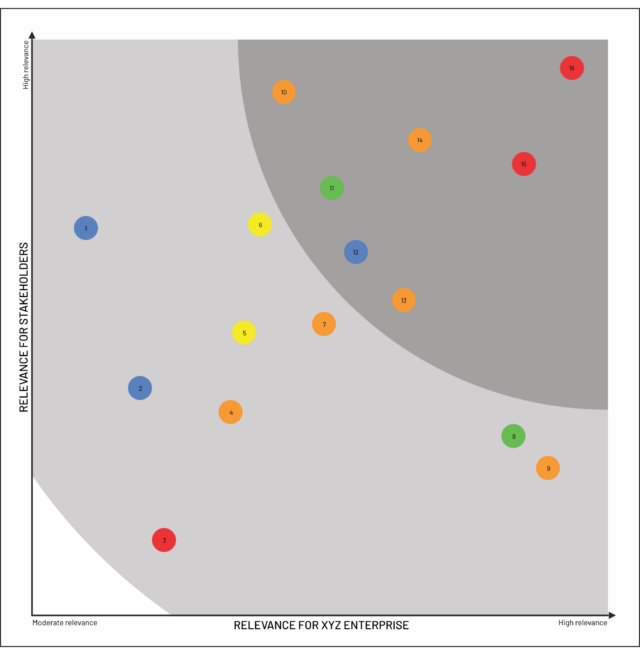
Shown above is an “elbow” and below the “knee” variant where the background colour indicates the importance of materiality issues in addition to the axis labels.
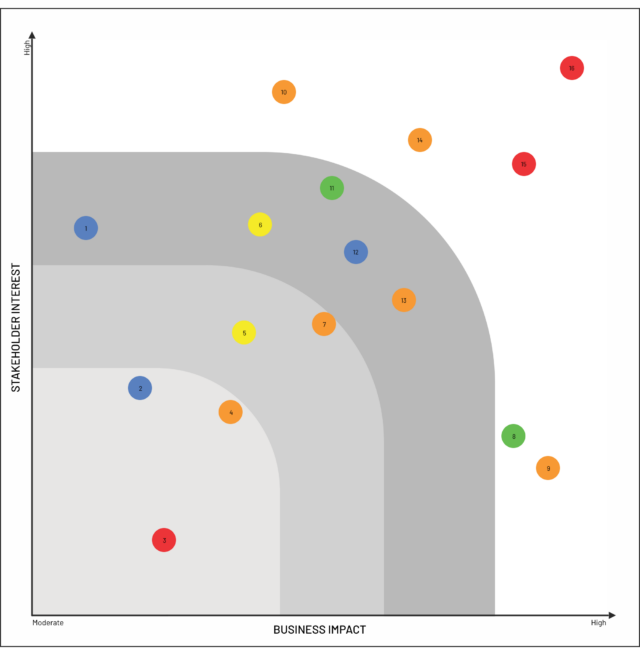
There are other variants where additional graphic elements like lines and background colour are used.
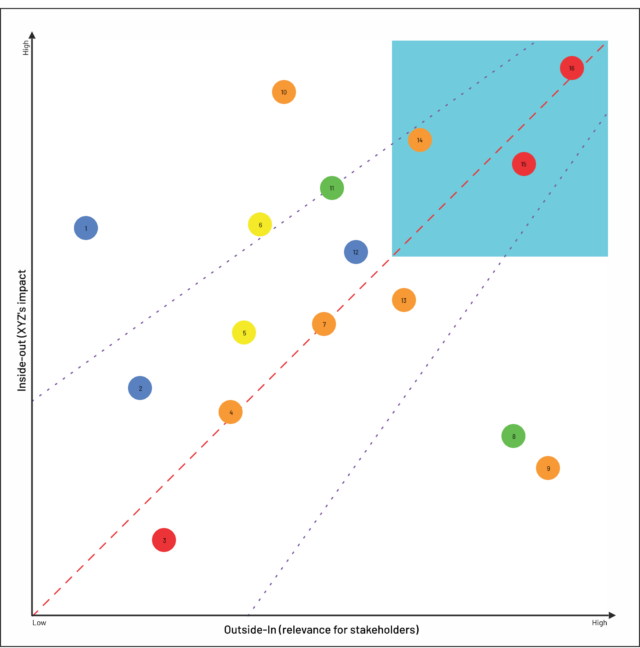
Scatter Bubbles
Scatter charts are another approach to a double materiality matrix. The topics identified as material to a company are depicted as bubbles and placed inside the matrix.
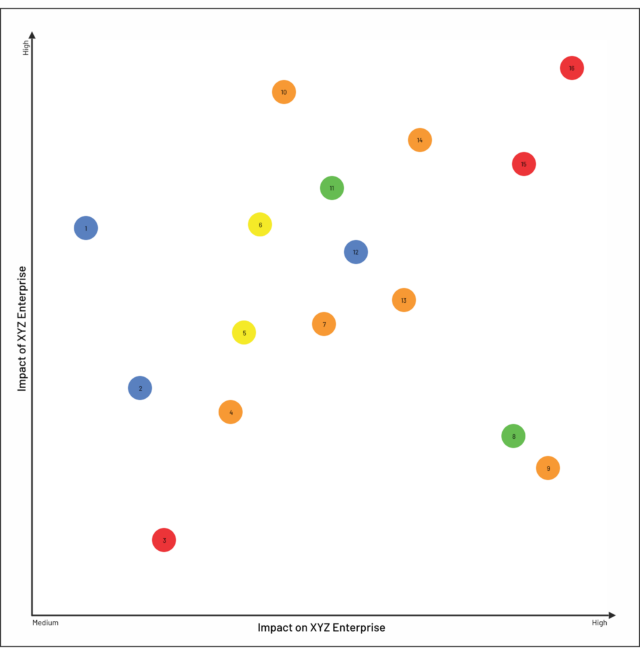
One example is given in the figure above with axis labels from “medium” to “high”, while the figure below shows a case where numeric values are used to mark the axes.
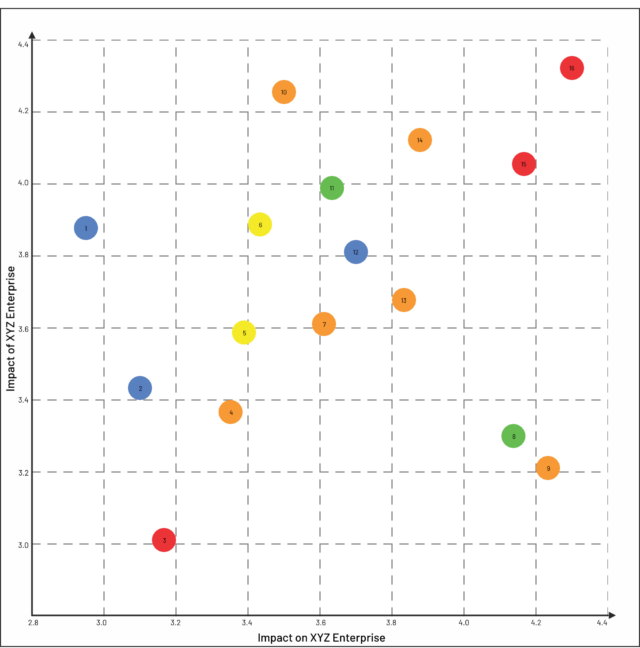
Finally, there are variants where the size of the bubbles varies to indicate the importance of a materiality issue.
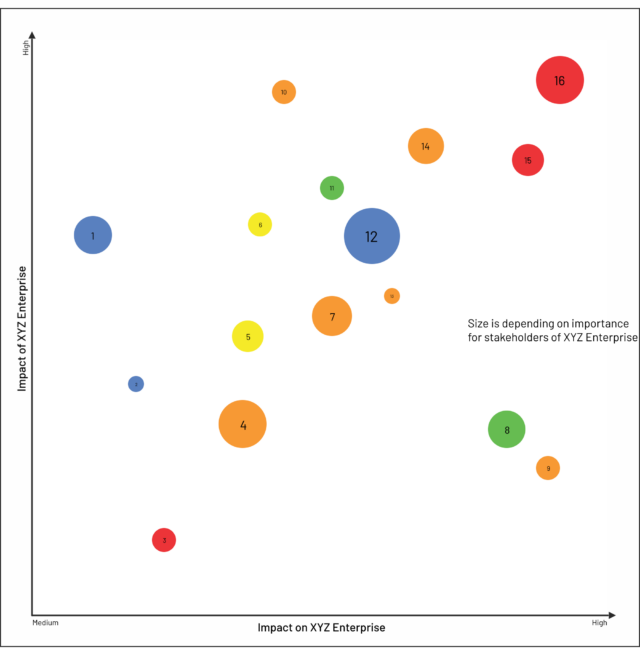
So what is “the best” option? In the next chapter, we discuss our approach that might be used as a starting point by those needing to prepare a materiality matrix.
Got questions about materiality?
Book a free and nonbinding discovery call to discuss your questions with one of our sustainability experts, and learn how we can help you.
A starting point
Materiality assessments should be data-driven, and the representation of the results should reflect this approach. So here is our addition to the wide variety of double materiality matrices.
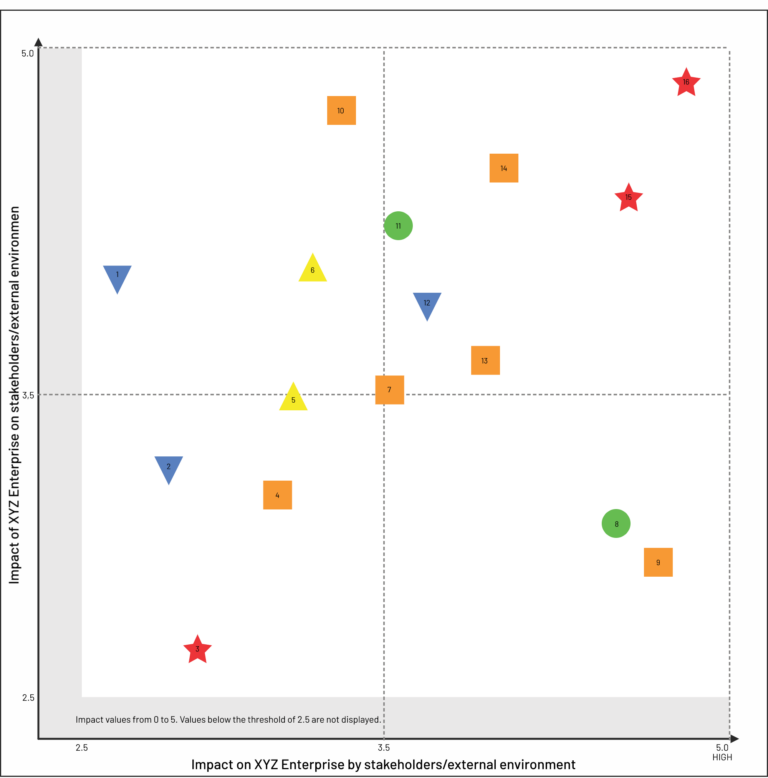
Let us share some of the thoughts that came to our mind when we created this variant:
- End-user: What are the demands of the end-users? Most likely, stakeholders like investors will examine the materiality matrix and want to understand what is material to a company they consider investing in. Therefore it may be a good idea to present both levels of information: What is material and, based on a given scale, to what extent is it material? Can a two-by-two matrix satisfy the demand for granular materiality data?
- Labels: Instead of adding titles like “medium” or “high” to each axis, consider using numeric values, indicate the bandwidth (e.g. values from 0 to 5) and also indicate the thresholds used (e.g. values below 2.5 are not displayed). Doing so helps the end user better understand the scale and the excerpt shown in the double materiality matrix.
- Scale: Both axes should have the same scale. We understand that a ratio of 4:3 or even 16:9 is desirable from a design perspective. However, having different scales may lead to a different perception of the importance (say, the vertical scale is half the size of the horizontal scale) of materiality issues represented in the matrix.
- Prioritisation: While different “bubble sizes” can indicate the prioritisation of specific materiality issues, we do not recommend doing so in a double materiality matrix. The importance of a materiality issue is characterised by its coordinates (top right corner vs low left corner). So is a “bigger bubble” at the centre of the materiality matrix “more material” compared to a “smaller bubble” placed in the top right corner?
- Accessibility: Most people have no issues distinguishing a square from a circle. But some need help with determining yellow from orange or orange from red. We propose not only to use different colours but also to use different shapes to represent each category. Speaking from our experience, those burning the midnight oil may also appreciate this approach since features like time-based shifting of the display’s colour temperature make it sometimes difficult to distinguish colours.
Conclusion
A well-executed materiality assessment guides organisations towards sustainable practices and effective reporting. To ensure its usefulness and relevance, a data-driven approach is essential, enabling a clear understanding of the significance and impact of the material issues identified during the materiality assessment.
A materiality matrix is a crucial tool since it showcases the assessment results. However, going beyond a simple “high” or “low” classification might be crucial. The double materiality matrix should provide meaningful indicators to help stakeholders comprehend the significance of each identified issue.
Considering the information demands of different users, including potential investors, is essential when constructing the materiality matrix. By aligning the matrix with the interests and expectations of stakeholders, organisations can effectively communicate their sustainability efforts and address the specific information needs of investors.
Ultimately, the materiality assessment and the resulting matrix are essential stepping stones towards developing a robust sustainability strategy, setting targets, monitoring progress, and reporting to relevant shareholders. By embracing a comprehensive and data-driven approach to materiality assessment, companies can enhance their CSRD compliance and demonstrate their commitment to sustainability in alignment with the European Sustainability Reporting Standards.
[1] NordESG – Climate related data and the investors perspective – Insights from Eurosif
- Read our blog post here
[2] NordESG – Attracting investors by intelligent sustainability reporting
- Read our blog post here
[3] NordESG – How to get started with ESG
- Read our blog post here
[4] NordESG – ESRS is changing the rules
- Read our blog post here
[5] NordESG – How to conduct a Double Materiality Assessment
- Read our blog post here
[6] NordESG – The concept of Double Materiality
- Read our blog post here
About NordESG
NordESG is an advisory firm helping corporates develop, articulate and execute their ESG and sustainability strategies. Our work includes sustainability performance reporting support under various ESG frameworks, strategy development or conducting materiality assessments. By doing so, we help businesses meet their disclosure compliance requirements like CSRD but also help them proactively communicate their strategy to other stakeholders like investors, customers and local communities in which they operate. Our work is focused mainly on Europe and North America.
Discovery Call
Book a free discovery call below
Get in touch via email
Disclaimer
This communication is marketing material. The views and opinions contained herein are those of the author(s) on this page, and may not necessarily represent the views expressed or reflected in other NordESG communications or strategies.
This material is intended to be for information purposes only. It is not intended to provide and should not be relied on for accounting, legal or tax advice, or investment recommendations. Reliance should not be placed on the views and information in this document when taking individual investment and/or strategic decisions. Information herein is believed to be reliable, but NordESG does not warrant its completeness or accuracy.
Some information quoted was obtained from external sources NordESG consider to be reliable. No responsibility can be accepted for errors of fact obtained from third parties, and data and information contained in this communication may change in the future. The views and opinions expressed in this communication may change.